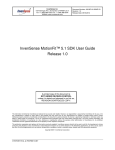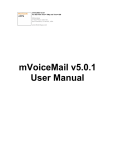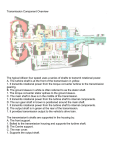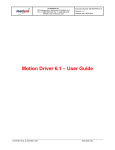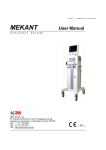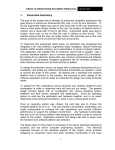Download Invensense Contextual Awareness-SDK 5.1.1 User Guide - Digi-Key
Transcript
InvenSense Inc.
1197 Borregas Ave.
Ave., Sunnyvale, CA 94089 U.S.A.
Tel: +1 (408) 9
988-7339 Fax: +1 (408) 988-8104
Website: www.invensense.com
Document Number: AN-MPU-9150IMF-03
AN
Revision: 1.0
Release Date: 04/01/2013
InvenSense Contextual Awareness
Awareness-SDK™ 5.1.1 User
Guide
Release 1.0
A printed copy of this document is
NOT UNDER REVISION CONTROL
unless it is dated and stamped in red ink as,
“REVISION CONTROLLED COPY.”
This information furnished by InvenSense is believed to be accurate and reliable. However, no responsibility is assumed by InvenSense
In
for its
use, or for any infringements or patents or other rights of third parties that ma
may
y result from its use. Specifications are subject to change
without notice. Certain intellectual property owned by InvenSense and described in this document is patent protected. No license
lice
is granted
by Implication or otherwise under any patent or patent rrights
ights of InvenSense. This is an unpublished work protected under the United States
CONFIDENTIAL & PROPRIETARY
InvenSense CA-SDK™ 5.1.1 User Guide
Release 1.0
Document Number:
Revision: 1.0
Release Date: 04/01/2013
copyright laws. This work contains proprietary and confidential information of InvenSense Inc. Use, disclosure or reproduction
reproductio without the
express written authorization of InvenSense Inc. is prohibited. Trademarks that are registered trademarks are the property of their
respective companies.
This publication supersedes and replaces all information previously supplied. InvenSense sensors should not be used or sold for
f the
development,
elopment, storing, production and utilization of any conventional or mass
mass-destructive
destructive weapons or any other weapons or life threatening
applications, as well as to be used in any other life critical applications such as medical, transportation, aerospace, nuclear,
n
undersea, power,
disaster and crime prevention equipment.
Copyright ©2011 InvenSense Corporation.
Table of Contents
1
PURPOSE AND SCOPE ................................
................................................................................................................................
..................................3
2
REVISION HISTORY ................................
................................................................................................................................
.....................................3
3
REFERENCE DOCUMENTS
CUMENTS AND SOFTWARE PACKAGES ................................................................
.............................................4
4
CA-SDK™ SDK ................................
................................................................................................................................
...............................................5
5
6
4.1
HARDWARE ................................
................................................................................................................................
...........................................5
4.2
SOFTWARE COMPONENTS NEEDED TO PROGRAM THE SDK ................................................................
.............................................6
4.3
SOFTWARE ................................
................................................................................................................................
............................................7
4.4
INVENSENSE SENSOR ................................
................................................................................................
..............................................................7
4.5
EXTERNAL SENSORS.............................................................................................................................
............................................................................................................................................
...............................................7
HARDWARE AND SOFTWARE
E SETUP
SETUP................................................................................................
........................................11
5.1
HARDWARE SETUP ................................
...............................................................................................................................
...............................11
5.2
SOFTWARE SETUP TO RUN THE DEMO APPLICATION ................................................................
....................................................12
5.3
USER INPUT ................................
................................................................................................................................
........................................13
PROGRAMMING THE SDK ................................
................................................................................................
..........................................................15
6.1
FIRMWARE. ................................
................................................................................................................................
.........................................15
6.2
HOW TO USE EMA 5.1.1 FEATURES AND INTEGRATE WITH AN APPLICATION ....................................................
................................
15
6.3
EMBEDDED MOTIONAPPS™ PLATFORM OVERVIEW ................................................................
.....................................................15
6.4
CALIBRATION AND SELF-TEST ................................
................................................................................................
.................................................15
6.5
ULTRA-LOW POWER FEATURES ................................................................................................
..............................................16
6.6
COMPILATION SETUP................................
.............................................................................................................................
.............................16
6.7
STEPS TO BRING UP THE PROJECT IN CODE COMPOSER STUDIO ................................................................
......................................16
6.8
REVIEW OF THE MLLITE_TEST.C FILE TO BUILD A SAMPLE APPLICATION WITH EMBEDDED MOTIONAPPS 5.1.1 .......19
CONFIDENTIAL & PROPRIETARY
2 of 19
InvenSense CA-SDK™ 5.1.1 User Guide
Release 1.0
1
Document Number:
Revision: 1.0
Release Date: 04/01/2013
Purpose and Scope
This document describes the InvenSense
enSense CA-SDK™ 5.1.1 User Guide. It is intended as a guide for the
user to run the CA-SDK™ with the PC or Android application.
2
Revision History
Revision Date
Revision
Description
04/01/2013
1.0
InvenSense CA-SDK™ 5.1.1 User Guide
CONFIDENTIAL & PROPRIETARY
3 of 19
InvenSense CA-SDK™ 5.1.1 User Guide
Release 1.0
3
Document Number:
Revision: 1.0
Release Date: 04/01/2013
Reference Documents and Software Packages
1. MPU-9250™ CA-SDK™
SDK™ Reference Board User Guide : General hardware guidelines for CA-SDK
CA
board
2. Embedded Motion Apps (eMA) v5.1.1 APIs Specification: Document describes eMA v5.1.1
v5.1. APIs
3. CA-SDK
SDK application: A sample application running on CA
CA-SDK
SDK board showing how to use and
configure eMA v5.1.1
4. Python eMA client: A PC application to interface and configure CA
CA-SDK
SDK application
5. Android CA-SDK client:: A android application to interface and configure CA
CA-SDK
SDK application
CONFIDENTIAL & PROPRIETARY
4 of 19
InvenSense CA-SDK™ 5.1.1 User Guide
Release 1.0
4
4.1
Document Number:
Revision: 1.0
Release Date: 04/01/2013
CA-SDK™ SDK
Hardware
Hardware Needed for Programming Using JTAG
•
CA-SDK™ SDK (http://www.invensense.com/developers
http://www.invensense.com/developers)
MPU-9250
MPU
Bluetooth
Module
Humidity and
Temperature sensor
MSP430 MCU
Micro USB
Pressure sensor
Light and proximity
sensor
UV sensor
Figure 4.1.0 MPU 9250 CA-SDK™ Board
Please refer to the MPU-9250™ CA
CA-SDK™ Reference Board User Guide for details on each of these
sensors and hardware schematics.
CONFIDENTIAL & PROPRIETARY
5 of 19
InvenSense CA-SDK™ 5.1.1 User Guide
Release 1.0
•
Document Number:
Revision: 1.0
Release Date: 04/01/2013
MSP-FET430UIF
FET430UIF flash tool ((http://www.ti.com/tool/msp-fet430uif))
Figure 4.1.1: Flash tool required for programming
4.2
Software Components Needed to Program the SDK
Loading Software on MCU
Option 1 – PC Program to load the software (that loads firmware on the MCU): Please install the
software (http://www.ti.com/tool/flash
http://www.ti.com/tool/flash-programmer)) on your PC. For questions on installation or
usage of this program please contact TI.
Option 2 - Code Composer Studio: The Code Comp
Composer
oser Studio from TI can be used for application
development on the SDK. Information on CCS can be obtained from http://www.ti.com/tool/ccstudio
or http://processors.wiki.ti.com/index.php/Download_CCS
http://processors.wiki.ti.com/index.php/Download_CCS.
Option 3- Boot Strap Loading via USB
BSL will comply with the standards from TI’s application note as below.
http://www.ti.com/lit/an/slaa452b/slaa452b.pdf
CONFIDENTIAL & PROPRIETARY
6 of 19
InvenSense CA-SDK™ 5.1.1 User Guide
Release 1.0
Document Number:
Revision: 1.0
Release Date: 04/01/2013
The option to load the program through BSL requires the existing software on the CA-SDK
CA
board to
have a BSL jump with a user interface. The software that is pre flashed on all CA
CA-SDK
SDK boards that are
shipped does come with the option of pressing the button to put the CA
CA-SDK
SDK in BSL where the user can
update their software using USB interface. A similar interface is recommended for
fo any software
updates from the developer to make this feature available.
For the software shipped with CA-SDK,
SDK, holding the button for two seconds with USB connected allows
for BSL jump. To be able to allow it in your program; use this line of code:
((void (*)())0x1000)();
For more details refer to checkClick() function in the source code and refer to this document:
4.3
Software
MotionApps-5.1.1
Firmware Embedded MotionApps
1. The CA-SDK™ board comes with preloaded software which interfaces with eMA and
outputs quaternion via a Bluetooth link. The code is implemented using Code Composer
Studio from TI. The link below provides the documentation for Code Composer.
omposer.
http://processors.wiki.ti.com/index.php/Category:Code_Composer_Studio_v5
processors.wiki.ti.com/index.php/Category:Code_Composer_Studio_v5 .
2. The default software settings for the CA-SDK application can bee changed according to the
eMA ™v5.1.1 API Specification document. Please check the mllite_test.c
mllite_test file in the
application release package for details of the implementation.
Feature
Settings
Quaternion Update Rate
20Hz
Quaternion Resolution
32 Bits
Quaternion Range
Full 360º
CA-SDK™ Software
To integrate eMA 5.1.1 you will need to locate the *.Hex file which is included in the CA-SDK software
package. Refer to the eMA™
™ v5.1.1 API Specification for supported API calls needed to build your
application. Except for the MPL library the entire software is available in source code for developers
developer to
showcase on how to interface the APIs. eMA
eMA™ v5.1.1 covers the MPU-9250
9250 sensors which are the
gyroscope, accelerometer, and magnetometer.
4.4
InvenSense Sensor
•
4.5
InvenSense MPU--9250: A 3-axis gyroscope, 3-axis accelerometer,
accelerometer and 3-axis
magnetometer integrated into a single package. The eMA™ v5.1.1 API covers
cover the
integration and calibration
calibrations for the MPU-9250.
External Sensors. Datasheets can be found inside the CA
CA-SDK
SDK zip file available for download in
the Developers Corner. http://www.invensense.com/developers/index.php?_r=default
ttp://www.invensense.com/developers/index.php?_r=default
CONFIDENTIAL & PROPRIETARY
7 of 19
InvenSense CA-SDK™ 5.1.1 User Guide
Release 1.0
Document Number:
Revision: 1.0
Release Date: 04/01/2013
•
Sensirion SHT21:: Temper
Temperature and humidity sensors. CA-SDK
SDK software provides the
driver for retrieving the rraw sensor data from the sensor.
•
Capella CM36682: Light and proximity sensors. CA-SDK software provides the driver
for retrieving the raw sensor data from the sensors
sensors.. The light sensor is provided as an
interface example and the proximity sensor is disabled by default for power concerns.
•
Capella CM3512:: UVI (ultra violet index) sensor. CA-SDK
SDK software provides the driver
for retrieving the UV index from the sensor
sensor.
•
ALSP HSPPA032A
2A: Pressure sensor. CA-SDK
SDK software provides the driver for
retrieving the pressure values.
The sensor_probe.c file in the CA-SDK
SDK software provides the needed APIs to retrieve the raw sensor
data from the external sensors.. In the main function, probe_setup_all_external_sensor () will probe,
and if any setup is needed will setup the sensors. The functions get_<sensor>_data (data) retrieves the
sensor data. Function make_protocol
ke_protocol () packages these sensors to be sent out using USB or UART. For
further information or other configuration please refer to the datas
datasheet
heet for the external sensors.
sensors
Macronix Serial Flash Driver for MX25L25635E
For information on the serial flash,
ash, please refer to MX25L25635E, LLD, v0.3.zip on the Macronix website.
Also, an example is given in test_flash() function .
Demos
Android client
1. This android application provides a way to evaluate the CA
CA-SDK
SDK board. The example application
can be downloaded from the play store. Please click the following link. The application
applicat
works with
Bluetooth connectivity.
Figure 4.3.0 is the startup menu in the
android application.
It gives an overview of present sensors.
The sensor values are collected from
the CA-SDK
SDK board, the methods for
calculating these values will be given
shortly.
Euler angles are updated using
quaternion packets received from eMA
5.1.1.
For more information on external
sensors and how to calculate them,
please check BluethoothDataReader.java class.
CONFIDENTIAL & PROPRIETARY
8 of 19
Figure 4.3.0
InvenSense CA-SDK™ 5.1.1 User Guide
Release 1.0
Document Number:
Revision: 1.0
Release Date: 04/01/2013
Temperature Sensor
Temperature = temperature [0] *256 + temperature [1
[1]
Temperature= (float) (-46.85
46.85 + 175.72 * (Temp
(Temperature / (2.0^16.0)))
Humidity Sensor
Humidity = humidity[0] *256 + humidity[1
humidity[1]
1- First remove the last three bits
For Android: float hex = Integer.parseInt(
Integer.parseInt("FFF8", 16);
Humidity = Float.intBitsToFloat(Float.floatToRawIntBits(Humidity)&
Float.floatToRawIntBits(hex));
2- Humidity = (float) (-6
6 + 125 * (Humidity /(2 ^ 16)))
Light Sensor
currLight = light[0] *256 + light[1
light[1]
currLight = currLight * 0.06103f;
Light = (currLight * .8f) + (Light * .2f
.2f)
UV sensor
UV = uv[0] *256 + uv[1]
UV = (UV * 0.022f) * 10
CONFIDENTIAL & PROPRIETARY
9 of 19
InvenSense CA-SDK™ 5.1.1 User Guide
Release 1.0
Document Number:
Revision: 1.0
Release Date: 04/01/2013
Figure 4.3.1 section consists of
all commands the user can send
to the CA-SDK board.
On the right, the cube uses
quaternion data to rotate. In the
middle debugging information
will be shown.
Figure 4.3.1
ns, and then click on Options
Options-> start Logging.
1- Enable some Display options,
2- When
hen logging, the Display commands will be disabled. The files will be saved
d in sdcard/CASDKClient.
Three log files will be created, one for external sensors (Pressure, Humidity
Humidity, Light,, UV, Temperature)
which is named sensors_TIME_external
external.csv and another for other sensors, named sensors_TIME.csv.
sensors
The third file debug_TIME.txt contains debugging Messages.
CONFIDENTIAL & PROPRIETARY
10 of 19
InvenSense CA-SDK™ 5.1.1 User Guide
Release 1.0
Document Number:
Revision: 1.0
Release Date: 04/01/2013
Python cube debug console app
2. The cube demo is written in python script and needs python instal
installed on the computer. This cube
demo lets users do more than just observe the orientation. For a complete set of functionality
please look at Software Setup to Run the Demo Application in section 5.2 of this document, or the
python eMA-client.py script
5
5.1
Hardware and Software Setup
Hardware Setup
Charge the unit via USB connector for 2 hours. Turn on the SDK using the DIP switch on the board.
1. Configure the Bluetooth interface on the PC. Go to ““control Panel\\All Control Panel
Items\Devices and Printers\\” then choose “Add a device” and choose blue “BlueRadios” device.
device
(figure 4.1.0)
2. If the computer asks for the password, enter “default”. (Zeros in numerical)
3. The PC will add the required driver to succes
successfully add the device to the PC.
4. Go to the Control Panel\All
All Control Panel Items
Items\Devices and Printers\ to properties and check
the port number of the Bluetooth serial port (figure 5.1.1.1).
.1). In this example the port number is
66, but we will call it just COM# from now on. After successfully pairing, power cycle the CASDK™ once by flipping the DIP switch OFF and ON.
CONFIDENTIAL & PROPRIETARY
11 of 19
InvenSense CA-SDK™ 5.1.1 User Guide
Release 1.0
Document Number:
Revision: 1.0
Release Date: 04/01/2013
Figure 5.1.1.0
.0 Adding BlueRadios tto the PC (Steps 1, 2, 3)
Figure 5.1.1.1 Right click the added device to go to properties and check the port number
(Step 4)
5.2
Software Setup to Run
un the Demo Application
Debug Console App (Optional demo to run if needed)
(eMA-client.py)
A debugging console application is provided to aid developers using the CA-SDK™. This
application is provided as Python source code. It has the following functionality:
1. Provides a console for MPL
MPL_LOG messages.
2. Provides a simple cube demo for visualizing sensor fusion output.
Because the debug console is provided as Python source code, the user will need to install the
following components to have a working Python environment
environment.
1. Python 2.7: The debug console was tested with Python 2.
2.7 on Windows 7 and Windows 8.
Download it from http://www.python.org/download/releases/2.7.4/
2. Pyserial 2.6:: The debug console requires pyserial to ccommunicate
ommunicate on the serial
seri port.
Download the Python 2.6 source code from https://pypi.python.org/pypi/pyserial
CONFIDENTIAL & PROPRIETARY
12 of 19
InvenSense CA-SDK™ 5.1.1 User Guide
Release 1.0
Document Number:
Revision: 1.0
Release Date: 04/01/2013
3. Pygame 1.9.1: The debug console uses the pygame library to render the cube demo. Release
for 86x: http://pygame.org/ftp/pygame
http://pygame.org/ftp/pygame-1.9.1.win32-py2.7.msi / Pygame 1.9.2.. windows binaries
for 64x release from http://www.lfd.uci.edu/~gohlke/pythonlibs/#pygame
4. You must install Python before installing the pyserial and pygame libraries. After installing
python use the command prompt to iinstall pyserial (command prompt needs to point to
location of pyserial), “python install pyserial.py”.
5. You will want to add Python to your PATH for convenience. In Windows, right click on My
Computer, select Properties, then in the advanced tab, and select Environment Variables. In
the user variables (top section), select Path, click Edit, and add the directory C:\Python27
C:
to
the end of the list.
6. Once you have a working Python environment, you can run the debug console application
from the command line with the command. To accept data one has to give the python
location of the python cube relative to the release folder as below
below.
7. CA-SDK_With_eMA511_Release.zip
511_Release.zip\CA-SDK_With_eMPA511_Release\core
core\eMA-hal\eMAClient
8. python eMA-client.py
.py <comport>
Where <comport> is the COM# as described in figure 5.1.1.1
Figure 5.2.2
5.2.2: Cube Demo Application running on console
5.3
User Input
To enable or disable certain functionalities, ffirst enter “inv”” followed by following case:
case '8': Toggles Accel sensor
case '9': Toggles Gyro sensor
case '0': Toggles Compass sensor
case 'a': Prints Accel sensor
case 'g': Prints Gyro sensor
case 'c': Prints Compass sensor
CONFIDENTIAL & PROPRIETARY
13 of 19
InvenSense CA-SDK™ 5.1.1 User Guide
Release 1.0
Document Number:
Revision: 1.0
Release Date: 04/01/2013
case 'e': Prints Eular data in radius
case 'r': Prints Rotational Matrix data
case 'q': Prints Quaternion
case 'h': Prints Heading in degrees
case 'k': Prints Pressure, Temperature, UV, Light, Humidity
case 'm': Start/Stop
p Magnetic disturbance algorithm
case 'n': Get eMA version
case 'w': Get Compass status and Accuracy
case 't' Run Calibration
case '1' to case '4' : Slow down or speed up the rate of sensors
case 'x': reset msp430
case 'v': Toggle LP quaternion
For more cases refer to eMA 5.1.1. Source code in handle_user() function
CTLR + S: Start logging
CTLR + T: Stop logging
The files will bee saved in Logs folder created in your python script location.
To Note:
1- For logging, to start user needs to have at least one sensor display enabled
enabled.
2- In case a sensor is running on startup of eMA
eMA-Client.py,
Client.py, first use ‘invx’ to go to default setting. It
is needed for logging data.
3- Sensors need to be enabled on start of python script and if they are running already, the
program is not in default setting, and their data will not be save
saved in logs.
4- When logging has started, user cannot disable/enable any sensor display or toggle any sensors.
a. Cases: 8, 9, 0, a, g, c, e, q, r, h, k will not be recognized
5- Two log files will be created, one for external sensors (Pressure, Humidity, Light, UV,
Temperature) which is named External_TIME.csv and another named all_TIME.csv
all_TIME
There are three packages that python script accepts,
1- debug_packet:: used to show any debugging messages
2- quat_packet: used for rotating cube
3- data_packet: contains sensors information
a. All conversion formulas which reads data from eMA 5.1.1 and translate it to meaningful
numbers can be found
und in __init__() function of data_packet class.
CONFIDENTIAL & PROPRIETARY
14 of 19
InvenSense CA-SDK™ 5.1.1 User Guide
Release 1.0
6
Document Number:
Revision: 1.0
Release Date: 04/01/2013
Programming the SDK
6.1
The CA-SDK™ comes pre-flashed
flashed with software needed to ggenerate calibrated
ed quaternion. The
remainder of this section is needed only if the user would need to modify the embedded
firmware.
6.2
How to use eMA 5.1.1 Features and Integrate with an Application
The CA-SDK™
™ package comes with an example application (that instantiates eMA v5.1.1
5.1.1 API calls) to
transmit sensor fusion data via serial UART. The next sections cover details about the eMA
architecture and example application code
code.
6.3
Embedded MotionApps™ Platform Overview
Embedded MotionApps 5.1.1 has been designed with a new architecture as explain
explained
ed below. The new
architecture provides customers with a much more modular MotionTracki
MotionTracking
ng solution that consumes
much less application processor resources, improving the overall power consumption.
There are three basic components in this architecture:
•
•
•
6.4
Embedded Hardware Abstraction Layer (HAL):
a. This is the central point of communication between eMA,, device drivers,
drivers and the
applications.
b. HAL provides function calls to initialize, enable, start, stop, and control all features
in eMA. Please refer to [2
[2] for further details.
Embedded MotionProcessing Library ((eMPL):
a. eMA provides a plug
plug-in
in framework for single function features (e.g. gyro bias
calibration, 9-axis
axis MotionFusion, etc.)
etc.).
b. eMA provides a w
well-defined
defined flow to register/unregister, initialization, start, stop,
and generate
ate features. Please refer to [2
[2] for further details.
Embedded Motion Driver:
river:
a. Device drivers for all supported InvenS
InvenSense sensors.
Calibration and Self-test
Embedded MotionApps consists of the following key calibration and self
self-testt features:
Calibration:
• Calibration for gyro bias
Fast no motion (<1 second convergence time)
Standard no motion (8 second convergence time)
SW temperature compensation
• InvenSense proprietary compass calibration
Standard fit
Vector
CONFIDENTIAL & PROPRIETARY
15 of 19
InvenSense CA-SDK™ 5.1.1 User Guide
Release 1.0
Document Number:
Revision: 1.0
Release Date: 04/01/2013
Small Motion using gyro
Self-test:
• Integrated MotionTracking device based self
self-test for gyroscope in the MPU-9250
9250 (Refer to [2]
for further details).
• Integrated MotionTracking device
device-based self-test for accelerometer in the MPU-9250
MPU
(Refer to
[2] for further details).
• Integrated MotionTracking device
device-based self-test for compass in the MPU-9250
9250 (Refer to [2]
for further details).
• Self-test is integrated into the respective device drivers
drivers.
Please refer to [2]] for a brief description of iindividual calibration functions and
d recommended settings.
6.5 Ultra-Low Power Features
The ultra-low
low power features introduced in this release and listed below support fully autonomous
operation, completely independent
ndependent from the application processor:
•
•
•
•
DMP-based pedometer
DMP-based gestures
Directional Tap
Orientation (including Flip)
Screen Orientation
Low Power Quaternion
Low Power 6-Axis
Axis Sensor Fusion
In general, please refer to [2]] on the description, usage
usage, and integration of each of the above features.
features
6.6
Compilation Setup
The Embedded MotionApps™ Platform requires Code Composer St
Studio
udio v4.0 or later and the default
chip selected is MSP430F5528 which is the one on the CA-SDK board.
6.7
Steps to Bring Up the Project in Code Composer Studio
•
Download and install the Code Composer SStudio from the TI website
(http://www.ti.com/tool/ccstudio
http://www.ti.com/tool/ccstudio).
). Please note that TI offers a free version of CCS which has
restrictions on code size that makes it unusable with the CA-SDK™ hence you would need the
full featured version. TI offers a trial version of the software which can be used for configuring
your CA-SDK application.
•
Download
nload the release package from the D
Developers Corner
orner and unzip (or 7zip) the folder to
extract the Embedded MotionApps eMA-5.1.1 software.
•
Open the Code Composer,
omposer, go to File -> Imports as in figure below.
CONFIDENTIAL & PROPRIETARY
16 of 19
InvenSense CA-SDK™ 5.1.1 User Guide
Release 1.0
Document Number:
Revision: 1.0
Release Date: 04/01/2013
•
Open Existing CCS/CCE Eclipse Projects
Projects.
•
Browsee the folder where the eMA is located and open the project.
•
Now the project opens up and it is ready to compile, look for the main.c file to see how the
example project
roject is being integrated into eMA.
Figure 6.
6.9.0: Select import to import the project
CONFIDENTIAL & PROPRIETARY
17 of 19
InvenSense CA-SDK™ 5.1.1 User Guide
Release 1.0
Document Number:
Revision: 1.0
Release Date: 04/01/2013
Figure 6.9.1: Open the existing project and put it in the project
CONFIDENTIAL & PROPRIETARY
18 of 19
InvenSense CA-SDK™ 5.1.1 User Guide
Release 1.0
6.8
Document Number:
Revision: 1.0
Release Date: 04/01/2013
Review of the mllite_test.c File to Build a Sample Application
pplication with Embedded MotionApps
5.1.1
The file is self-explanatory in termss of inline documentation and therefore we will go through the
important steps only. This example application program is designed to continuously transfer
quaternion data at 50Hzz update rate. The value of the quaternion is transmitted to the UART port and
then transferred via Bluetooth module. The previous section shows how to use the program with PC
applications.
•
msp430_clock_init(12000000L, 2); msp430_i2c_enable(); msp430_int_e
msp430_int_enable();
nable();
msp430_uart_init(); is needed to setup the system layer functions. This will enable the I2C,
clocks, and UART functionality
unctionality in the project
project. Initial_Spi(); to enable flash read/write.
•
It is very important to initialize using inv_init_mpl(). It should be called first and once.
•
Starting eMA using inv_start_mpl() will enable eMA.. Here are the major default values
valu which
are initialized. There are other defaults sets as well.
o
20
0 Hz fifo output rate (This is the default and can be changed)
o
Range for accelerometer can be set using gyro_set_accel_fsr();
o
Gyro range can be set using gyro_set_gyro_fsr()
•
In this example application the MCU continuously transmitss the data and is set in a loop. Based
on the application one can change the use case of the app
application.
•
inv_execute_on_data() will process the data it has received and update all the internal states
and features that have been turned on. This function should be called after at least one of
inv_build_gyro(), inv_build_accel(), or inv_build_compass() has been called.
•
eMA_send_quat(data); this function packages the quaternion and sends
ds it out using the UART
module at 115200 baud rate.
7. Known Issues
7.1
For MSP430 security Fuse blown:
http://e2e.ti.com/support/microcontrollers/msp430/f/166/t/166038.aspx
http://e2e.ti.com/su
http://e2e.ti.com/support/microcontrollers/msp430/f/166/t/121347.aspx
pport/microcontrollers/msp430/f/166/t/121347.aspx
7.1
Default Frequency is 20 Hz; frequencies above this with compass enabled
enable will
cause interruptions.. Future versions will address this issue.
CONFIDENTIAL & PROPRIETARY
19 of 19



















